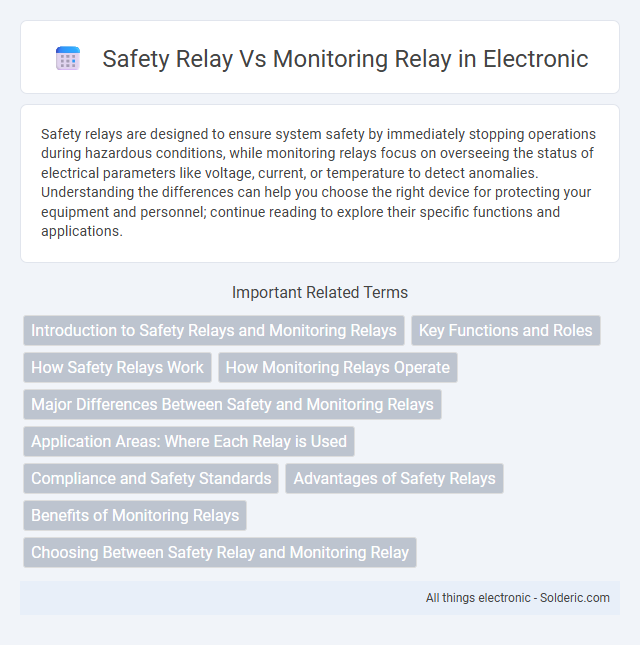Safety relays are designed to ensure system safety by immediately stopping operations during hazardous conditions, while monitoring relays focus on overseeing the status of electrical parameters like voltage, current, or temperature to detect anomalies. Understanding the differences can help you choose the right device for protecting your equipment and personnel; continue reading to explore their specific functions and applications.
Comparison Table
| Feature | Safety Relay | Monitoring Relay |
|---|---|---|
| Purpose | Ensures safety functions by monitoring emergency stops and safety devices | Monitors operational parameters like voltage, current, and phase sequence |
| Application | Machinery safety systems, emergency stop circuits | Control systems, motor protection, signal monitoring |
| Standards Compliance | Meets strict safety standards (e.g., ISO 13849, IEC 62061) | Not designed for safety standard compliance |
| Functionality | Detects faults, ensures failsafe operation, forces safe shutdown | Detects abnormal operating conditions, triggers alarms or control actions |
| Output | Redundant contacts for safety circuit interruption | Standard relay contacts for monitoring signals |
| Fault Handling | Failsafe design to prevent hazardous situations | Alerts on parameter deviations but does not guarantee failsafe |
| Cost | Typically higher due to safety certification and redundancy | Usually lower, focused on monitoring functions |
Introduction to Safety Relays and Monitoring Relays
Safety relays are specialized devices designed to detect faults and initiate emergency stops in industrial machinery to ensure operator protection and compliance with safety standards. Monitoring relays, on the other hand, continuously supervise electrical parameters such as voltage, current, or phase sequence to maintain optimal system performance and prevent equipment damage. While safety relays prioritize human safety through rapid fault response, monitoring relays focus on maintaining operational integrity by tracking system conditions.
Key Functions and Roles
Safety relays are designed to monitor and ensure the safe operation of machinery by detecting faults and initiating emergency stop functions to protect personnel and equipment. Monitoring relays primarily oversee operational parameters such as voltage, current, and phase sequence to maintain system health and prevent damage. Your choice between safety and monitoring relays depends on whether the application requires critical safety intervention or continuous condition supervision.
How Safety Relays Work
Safety relays operate by continuously monitoring safety inputs such as emergency stop buttons or safety gates and immediately disconnecting power to hazardous machinery if a fault or unsafe condition is detected. They use dual-channel input circuits and internal redundancy to ensure high reliability and compliance with safety standards like ISO 13849 or IEC 62061. This reliable switch-off mechanism prevents accidents by rapidly halting operations during emergency situations or system failures.
How Monitoring Relays Operate
Monitoring relays operate by continuously tracking electrical parameters such as voltage, current, or phase sequence to detect abnormalities and signal faults in machinery or systems. They ensure operational safety by triggering alarms or shutting down equipment when monitored values deviate from predefined thresholds, preventing damage or hazardous situations. Unlike safety relays, monitoring relays primarily focus on fault detection without directly implementing safety-rated control functions.
Major Differences Between Safety and Monitoring Relays
Safety relays are designed to ensure the safe shutdown of machinery in hazardous conditions by monitoring critical safety functions such as emergency stops, light curtains, and safety gates, whereas monitoring relays primarily track operational parameters like voltage, current, and phase sequence to protect equipment from electrical faults. Safety relays must comply with stringent safety standards like ISO 13849 or IEC 61508, providing fail-safe outputs and redundancy, while monitoring relays focus on equipment protection without direct involvement in emergency stop functions. Your choice between these relays depends on whether the application requires safety-critical control or general equipment status monitoring.
Application Areas: Where Each Relay is Used
Safety relays are predominantly used in critical industrial applications such as emergency stop circuits, machine guarding, and hazardous area controls, ensuring compliance with international safety standards like ISO 13849 and IEC 62061. Monitoring relays are primarily found in equipment protection roles, including motor overload protection, phase failure detection, and monitoring voltage or current levels to prevent damage. Your choice between these relays depends on whether the application demands strict safety function enforcement or continuous condition monitoring.
Compliance and Safety Standards
Safety relays comply with strict international standards such as ISO 13849 and IEC 62061, ensuring reliable operation in emergency stop systems and machinery protection. Monitoring relays meet relevant compliance requirements for system diagnostics and fault detection but are generally not certified for direct safety-related control functions. Both relay types contribute to overall safety, but safety relays are essential for meeting mandatory safety standards in high-risk industrial environments.
Advantages of Safety Relays
Safety relays offer enhanced reliability and fast response times, ensuring critical machinery protection by immediately stopping equipment during hazardous conditions. They comply with stringent safety standards such as ISO 13849 and IEC 62061, providing higher risk reduction levels compared to monitoring relays. Your system benefits from the fail-safe design and self-monitoring features of safety relays, minimizing downtime and preventing accidents effectively.
Benefits of Monitoring Relays
Monitoring relays offer enhanced protection by continuously checking the status of critical electrical parameters such as voltage, current, and phase sequence, preventing equipment damage and reducing downtime. Your system's reliability improves significantly as monitoring relays detect faults early, enabling proactive maintenance and avoiding costly failures. Unlike safety relays, monitoring relays focus on operational health, ensuring optimal performance and safeguarding your electrical installations.
Choosing Between Safety Relay and Monitoring Relay
Choosing between a safety relay and a monitoring relay depends on the criticality of the application and the required level of risk reduction. Safety relays are designed to perform safety functions by ensuring reliable shutdown in hazardous situations, complying with safety standards such as ISO 13849-1 and IEC 62061. Monitoring relays, on the other hand, focus on supervising specific electrical parameters like voltage, current, or phase sequence to maintain equipment performance without directly performing safety-critical shutdowns.
Safety relay vs monitoring relay Infographic

 solderic.com
solderic.com